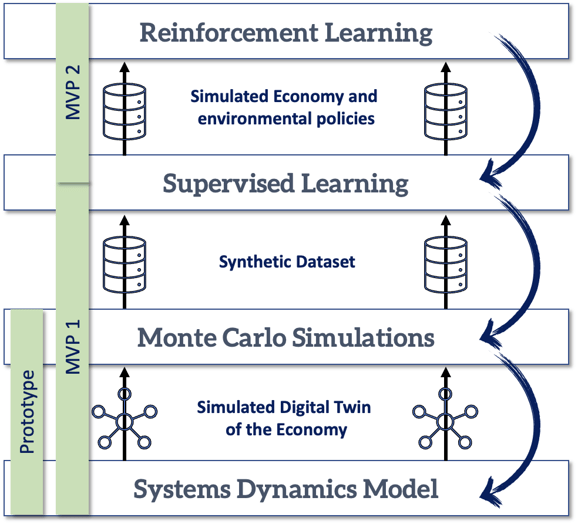I have long nurtured a passion for the concept of digital twins. Some years ago, we developed a dynamic multi-agent environment that could self-organize based on business rules to achieve desired outcomes. This environment harnessed swarm intelligence and genetic algorithms to discover new pathways for achieving these outcomes. In some instances, the focus was on optimizing inventory; in others, it revolved around profitability, quality, and more frequently, finding the delicate balance between these competing objectives. This balance-seeking was essential due to the multitude of competing goals within most organizations. The underlying logic here is that comprehending how these competing objectives interact within the business system is daunting, necessitating automation to ascertain the impacts of decisions and determine the optimal resource configuration across all these objectives.
I vividly recall presenting this concept to Microsoft's leadership at that time, only to receive the response that such AI solutions were not within Microsoft's core business focus, which was then concentrated on MS Office. Looking ahead a few years, it's remarkable to witness how this stance has shifted.
Although we eventually ran out of funding to fully realize our multi-agent environment, the dream remained alive. The emergence of DAOs (Decentralised Autonomous Organisations) seemed promising—a step toward achieving some form of autonomy in managing business resources for desired outcomes. However, the adoption of DAOs has been somewhat limited. Nonetheless, a new concept, the digital twin, has taken center stage. Presently, the digital twin landscape seems more centered on tangible second and third-order challenges, such as vehicles, ships, turbines, and accident scenes. However, we've managed to extend this concept into the abstract realms of businesses using system dynamics.
A system dynamics model empowers you to encode the dynamics of an entire business or ecosystem, enabling thorough experimentation with the effects of competing objectives on one another and the overall system performance. What you have is a “living business model”, that allows you to simulate business configurations, issues, and plans, explaining past performance and projecting future outcomes under varying scenarios and strategies. It's easy to foresee how these models can generate extensive sets of synthetic data by manipulating the variables (levers) in the system. It's essential to note that a system dynamics model derives data from the structure, whereas machine learning constructs structure from data.
Using sensitivity analysis and payoff optimization algorithms on this living business model can produce datasets that serve two primary purposes:
- Generating volumes of synthetic data for machine learning purposes — data that isn't historical but closely resembles designed data.
- Providing data and rule sets for an environment and agents in a reinforcement learning paradigm, thereby generating new outcomes and scenarios independent of historical data.

The crux lies in crafting a digital twin that enables strategic experimentation within the environment to approach the optimal structure. Through continuous experimentation and optimization, remarkable proximity to the right structure can be attained. The only piece missing from this puzzle is feeding the AI models back into the structured system dynamics model for optimization. All good things come to those who wait. Once this is done we may just be one step closer to a new form of DAO.
The challenge at the moment is that existing digital twin solutions focus either on the strategic domain or the operational domain, but seldom at the intersection to provide a holistic offering.
The operational domain is densely populated with numerous business and enterprise modeling platforms striving to encapsulate different facets of a business. The primary hurdles in this space include: (1) accurately inputting data into these tools, and (2) maintaining updated data to continually provide insightful decision-making support.
Conversely, the strategic domain necessitates a sophisticated skill set, tool set, and knowledge set that isn't readily available off the shelf. While these tools are complex, the mindset and expertise required to effectively wield them are substantial — attributes that are gradually improving if the talent at the latest system dynamics conference, is anything to go by.
As with most things, a balance exists between the two domains. What is required is a distinct and complementary skill set and toolset for both of these domains:
1. For the strategic domain - A system dynamics skillset and toolset that devises and maintains a digital twin at the systemic and ecosystemic levels, yielding strategic insights into business models, policies, and strategic inquiries. This skill set requires a solid understanding of the patterns of systems, the different levers that are effective, statistical models that can represent these patterns, and tools and techniques like regression analysis. Business model innovation stereotypes are super handy at this level as well as the system archetypes. The tool used in this space should be able to design system dynamics models, run sensitivity tests, payoff, and optimization algorithms, and also support agent-based modeling and execution. We use Stella Architect for system dynamics modeling and simulation.
2. For the operational domain - An operational skill and toolset that constructs and sustains the digital twin at the business level, providing operational insights into resource utilization, efficiency, profitability, and optimization. This is all about value streams, processes, and understanding what activities move assets/stocks through the operational part of the business. process modeling and optimization skills as well as organization design to address the FORM and structure of the resources and business to be able to deliver the outcomes. Whilst this can be done in system dynamics tools it gets way too gnarly and complicated so more operational toolsets have a stronger offering for the complexities down at this level. We use BOC ADONIS for operating model design and optimization.
Recently, I've encountered tool sets attempting to bridge both domains. While the tools themselves offer this capability, the rare skill set, knowledge, and mindset needed to harness them optimally are in short supply, as most individuals' skill sets and experiences align more with one domain or the other. This might present an opportunity for upskilling and certainly warrants contemplation on the advantages of a digital twin encompassing strategic, business, and operational ecosystems and the questions it can address.
Feel free to connect with us at DesignChain to explore the available options for your organization. We offer services that span both these domains at a skillset, toolset, knowledge set, and mindset level.




